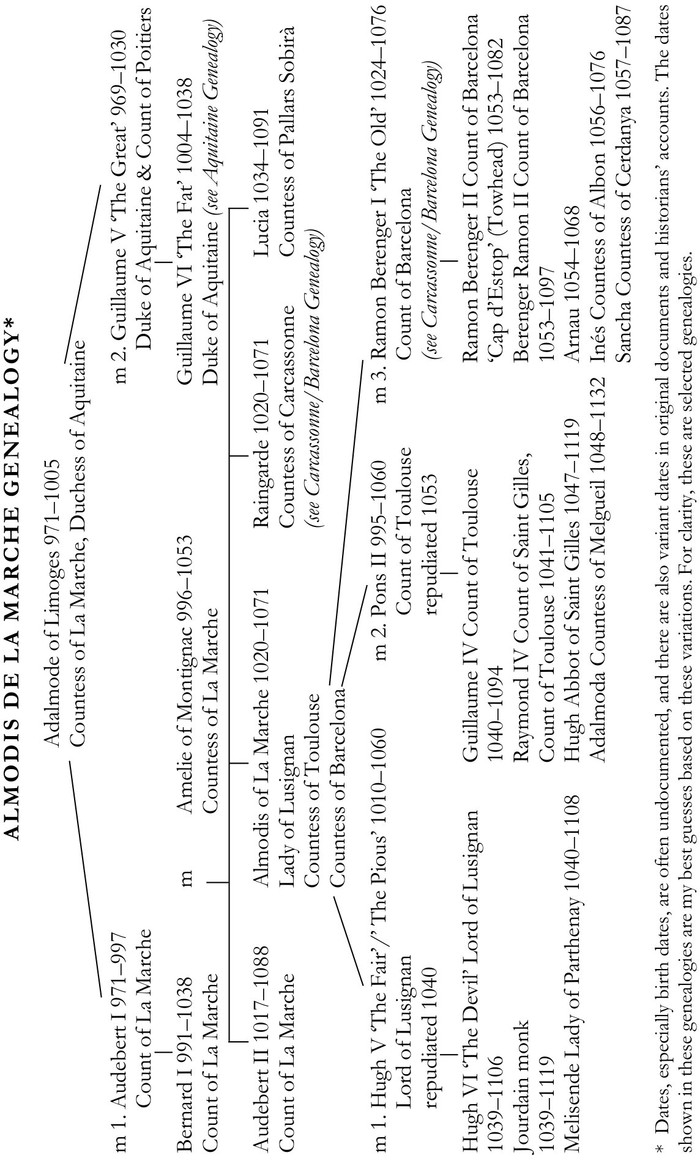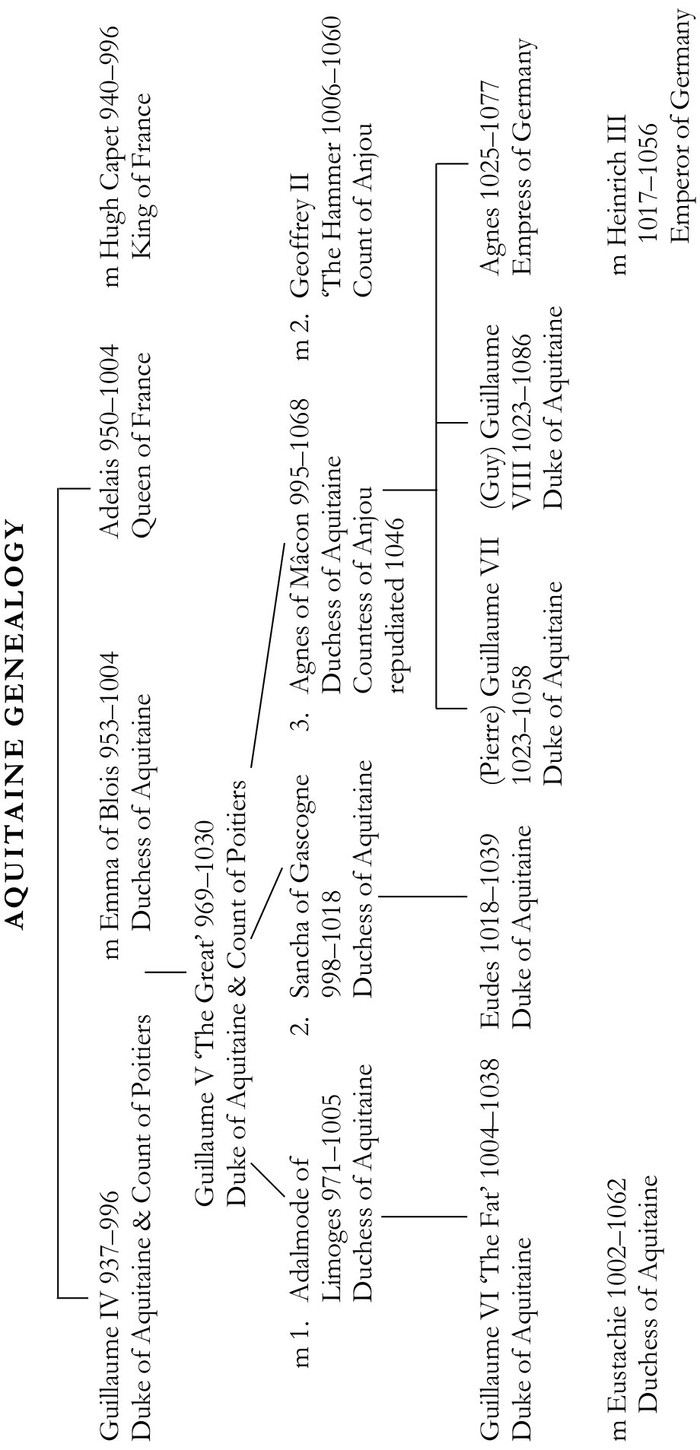Authors: Tracey Warr
Almodis (34 page)
Almodis de La Marche was a real historical person. That she was repudiated, kidnapped and murdered, that she was three times married, had twelve children, played an active role in the government of Toulouse and Barcelona, and was literate, are all documented facts. It was a story that needed writing! Everything in between these basic facts I have imagined and am responsible for any historical inaccuracies. I am not a medievalist and have drawn only on sources in modern English and French, and whilst based in research, this is a work of fiction rather than history.
Almodis was the ancestor of Eleanor of Aquitaine, and Geoffrey of Anjou was the ancestor of Henry II King of England, who married Eleanor. There is no historical evidence that Almodis was herself a twin, but it is likely that she gave birth to at least two sets of twin sons, and it is possible that her sister Raingarde was her twin. For nineteen years Almodis and Ramon ruled
Barcelona
, consolidating its power base. Their tombs are in Barcelona Cathedral. The eleven children who survived her went on to rule large parts of northern Spain and southern France, and played significant roles in the Crusades. Her sons by her three husbands were strong allies. Her descendents through the Lusignan family ruled Jerusalem and Cyprus in the thirteenth century and
eventually
gained control of the county of La Marche.
The lords and ladies in this story are based on historical people, whereas the characters who are not nobility: Dia,
Bernadette, Piers, Alienor, Carlotta, Rostagnus and others, are my inventions, although Dia has been inspired by the female troubadours of the twelth century. The events and personalities described in this book are a mixture of fact and fiction. There is one piece of conscious poetic license: Elisabeth of Vendôme
was
burnt at the stake in her wedding dress by Fulk of Anjou for infidelity with a goatherd, however Geoffrey’s mother was Fulk’s second wife, Hildegarde.
Diverse spellings of names are used by historians and in original documents ranging through Catalan, Occitan, French and
Anglicised
. The use of surnames had not yet developed in the eleventh century and first names were passed down in families resulting in a profusion of Hughs, Ramons, Berengers and Garsendas for instance. In order to avoid confusion I have slightly altered some names or used their real nicknames, except in the case of Hugh The Bishop, which is my own invention.
Places and geography are a mixture of fact and fiction. Whilst descriptions of Toulouse are based on eleventh-century maps of the city, for instance, my description of Saint Gilles in Chapter 21 is fictional and based on the village of Brousse Le Château in the Tarn Valley.
I have aimed to create a portrait of the time and culture that Almodis lived in, which were very different from stereotypical ideas about ‘the Middle Ages’. Southern France was a separate country from the territory north of the River Loire. South of the Loire a different language was spoken, there were different laws and a different culture. The counties of southern France had far greater ties with their neighbours across the Pyrenees in northern Spain than with northern France.
In the ninth century Charlemagne’s empire had extended through the modern-day territories of Germany, France, Italy and northern Spain, but the cohesion achieved by Charlemagne had fallen apart and noble families were fighting for control of small regions. Kingship was beginning to re-emerge with the Capetians in the North of France, but in the South there was no king, and counts such as La Marche were independent rulers, and lords such as the Lords of Lusignan gave only a fragile homage to their overlords, the Dukes of Aquitaine. The battles for control
were based as much on establishing lineage and allegiance through marriage and heirs, as they were on war.
One of the most distinctive features of this southern country was the prevalence of female lords, inheriting and ruling in their own right and as regents for their sons, or as co-lords with their husbands. It is clear from surviving documentation that
Occitanian
and Catalonian women were actively involved in political and economic life. Oaths were sworn on the matrilinear line; wives, sisters and mothers all had to give their consent to legal and fiscal acts undertaken by their men, as well as often acting themselves in these matters.
Eleventh-century southern French (Occitan) and northern Spanish (Catalan) society was sophisticated and intellectual, as well as a military and hierarchical mileau. The courts of Aquitaine and Anjou in particular were literate, where noble women learnt to read and write and were patrons of writers and book-makers.
Occitan was the language of the troubadours. Troubadours are usually associated with the twelfth century since this is when the first named poets such as Guillaume IX of Aquitaine (who married Almodis’ granddaughter), Bertran de Born, Bernart de Ventadorn and the Comtesse de Dia lived, however Peter Dronke has argued that, by 1000, all the basic types of medieval and
Renaissance
lyric had evolved and we can ‘reject any suggestion that the birth of secular vernacular lyric in western Europe was a
sudden
event that took place (as many people believe) at the end of the eleventh century’ (1996: 30). Both Martin Aurell (1995) and Jacques Le Goff (1980) have suggested that Almodis was the
canvas
for the
Roman of Melusine
, which was associated with the castle of Lusignan. The Jeux Floraux competition was founded around 1323 in Toulouse by seven troubadours and awarded a golden flower as its prize. The Occitan language is still spoken today in southern France and other areas. In the nineteenth century it was systematically suppressed in the
vergonha
, the shaming. It is still not recognised as an official language by the contemporary French government, although it is recognised by Spain.
The eleventh century was a time of relative peace in the region after the invasions by Muslims, Vikings and Magyars in the
previous
centuries. It was a time of transitions: transition from the
warrior caste of Almodis’ father’s generation to the more ordered and peace-seeking society of her own generation with the spread of the Peace and Truce of God which sought to reduce constant warring; transition in the traditions of inheritance from cognate division, in which all children, including daughters, inherited part of their parents’ rights, to agnate primogeniture which focussed inheritance on the eldest son; the beginning of shifts in the church from a priesthood with wives, to a celibate priesthood; from a church manipulated by the secular aristocracy, to a church that sought to control that aristocracy, and the gradual move towards the totalitarian church of the thirteenth century with the
concomitant
erosion of women’s rights and status.
The country of Occitania was wiped out 170 years after Almodis lived, in the Albigensian Crusade, when northern France, acting at the behest of the pope, repeatedly invaded and brutally subdued the South. Although presented as a religious crusade against the Cathars this was in effect a territorial
invasion
, a cultural subjugation of the South and of Almodis’ and Raingarde’s descendents who were the rulers of Toulouse and Carcassonne.
The work of historians and medieval writers were influential on my attempt to create a picture of this lost culture and I have put some of their choicest phrases into the mouths of my characters, especially Aurell, Bachrach, Bloch, Bogin, Bonnassie, Cheyette, Duby, Kosto, Painter, Adhémar of Chabannes, Dhuoda of Uzès, Gregory of Tours, Raldophus Glaber, Trota of Salerno, George Turbevile and William of Malmesbury. These and other key sources are listed below. Bernadette’s description of the great round of life was inspired by
The Creation Tapestry
in Girona Cathedral and the Duc de Berry’s
Very Rich Hours
. A full bibliography is on my website http://traceywarr.wordpress.com
Aurell, Martin,
Les Noces du Comte: Mariage et Pouvoir en Catalogne (785–1213)
(Paris: Sorbonne, 1995).
Bachrach, Bernard S.,
State-Building in Medieval France: Studies in Early Angevin History
(Aldershot: Variorum, 1995).
Bloch, Marc,
Feudal Society
, 2 vols. (Chicago: Chicago University Press, 1961).
Bogin, Meg,
The Women Troubadours
(New York: W.W. Norton, 1980).
Bonnassie, Pierre,
La Catalogne du milieu du Xe a la fin du XIe siècle
, 2 vols. (Toulouse: University of Toulouse, 1975–76).
Cawley, Charles,
Medieval Lands Project
online at: http://fmg.ac/ Projects/MedLands/index.htm
Chabannes, Adhémar de,
Chronique
, 3 vols., transl. Yves Chauvin et Georges Pon (Turnhout: Brepols, 2003). Written in the eleventh century.
Cheyette, Frederic L., ‘The “Sale” of Carcassonne to the Counts of
Barcelona and the Rise of the Trencavels’,
Speculum
, vol. 63 no. 4, 1988, pp. 826–64.
——
Ermengard of Narbonne and the World of the Troubadours
(Ithaca and London: Cornell University Press, 2001).
D’Arras, Jean,
Mélusine
, compiled 1382–94, English translation c.1500, ed. A.K. Donald (London: Kegan Paul, Trench, Trubner, 1895).
Dronke, Peter,
Women Writers of the Middle Ages: A Critical Study of Texts from Perpetua (d. 203) to Marguerite Porete (d. 1310)
(Cambridge: Cambridge University Press, 1984).
——
The Medieval Lyric
(Cambridge: D. S. Brewer, 1996).
Duby, Georges,
The Knight, the Lady, and the Priest: The Making of Modern Marriage in Medieval France
(London: Pantheon, 1983).
Duoda Women’s Research Centre, University of Barcelona http:// www.ub.edu/duoda/
Evans, Joan,
Monastic Life at Cluny 910–1157
(Oxford: Oxford University Press, 1968).
France, John, ed.,
Rodolfus Glaber: The Five Books of the Histories
(Oxford:
Clarendon Press, 1989).
Gies, Joseph & Gies, Frances,
Life in a Medieval Castle
(New York: Crowell, 1974).
Goldin, Frederick,
Lyrics of the Troubadours and Trouvères
(New York: Doubleday Anchor Books, 1973).
Green, Monica H. ed.,
The Tortula: A Medieval Compendium of Women’s Medicines
(Philadelphia: University of Pennsylvania Press, 2001).
Gregory of Tours,
The History of the Franks,
tr. Lewis Thorpe (London: Penguin, 1974). Written in the sixth century.
Herlihy, David,
Opera Muliebra: Women and Work in Medieval Europe
(New York: McGraw-Hill, 1990).
Karras, Ruth Mazo,
Sexuality in Medieval Europe: Doing Unto Others
(London: Routledge, 2005).
Kosto, Adam J.,
Making Agreements in Medieval Catalonia: Power, Order, and the Written Word,
1000–1200
(Cambridge: Cambridge University Press, 2001).
Le Goff, Jacques,
Time, Work and Culture in the Middle Ages
(Chicago: Chicago University Press, 1980).
Leighton, Albert
C., Transport and Communication in Early Medieval Europe AD500–1100
(Newton Abbot: David & Charles, 1972).
Lewis, Archibald R.,
The Development of Southern French and Catalan Society, 718–1050
(Austin: University of Texas Press, 1965). Published online at Library of Iberian Resources Online http://libro.uca.edu
Martindale, Jane,
Status, Authority and Regional Power: Aquitaine and France, Ninth to Twelfth Centuries
(New York: Variorum, 1997).
Moline de Saint-Yon, Alexander Pierre,
Histoire de Comtes de Toulouse,
4 vols. (Paris: A. Bertrand, 1859).
Morichon, René, ed.,
Histoire du Limousin et de La Marche
, Volume 1: De la Préhistoire à la Fin de l’Ancien Régime (Paris: René Dessagne, 1972–76).
Mundy, John Hine,
Liberty and Political Power in Toulouse 1050–1230
(New York: Columbia University Press, 1954).
Oldenbourg, Zoe,
Massacre at Mongségur: A History of the Albigensian Crusade
(London: Phoenix, 2000).
Painter, Sidney, ‘The Lords of Lusignan in the Eleventh and Twelfth Centuries’,
Speculum
, 32: 1, Jan. 1957, pp. 27–47.
Redon, Odile, Françoise Sabban, and Silvano Serventi,
The Medieval Kitchen: Recipes from France and Italy
(Chicago: University of Chicago Press, 1999).
Reynolds, Susan et al., ‘Translation of “Agreement between William V of Aquitaine and Hugh IV of Lusignan”’.
Medieval Sourcebook
online at http://www.fordham.edu/halsall/sbook.html
Robinson, James,
Masterpieces of Medieval Art
(London: British Museum, 2008).
Thiebaux, Marcelle, ed.,
Dhuoda, Handbook for her Warrior Son: Liber Manualis
(Cambridge: Cambridge University Press, 1998).
Thompson, James Westfall,
The Literacy of the Laity in the Middle Ages
, University of California Publications In Education, vol. 9 (Berkeley: University of California Press, 1939).
Turbevile, George,
Noble Arte of Venerie or Hunting (1576
) (Oxford: Clarendon Press, 1908).
William of Malmesbury,
De Gestis Regum Anglorum
(London: Bell, 1847).



